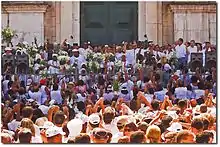
Brazil had a profound racial miscegenation, Brazilians have the most diverse physical characteristics.[1] Research indicates that 44% of Brazilians have two religions.[2] Official data from the Brazilian census indicate that 1,011,507 Brazilians have two religions or follow a syncretic religion.[3] Because to miscegenation it is common for a person to have a father of one race and religion and a mother of another race and another religion, naturally that person can adopt the two beliefs or follow a religion that mixes the two beliefs.[4]
.jpg.webp)
Many Afro-Brazilian religions are called Macumba,[5] but generally macumba is a vague word for any religion from Africa.[6] Tambor de Mina is a highly syncretic religious tradition, combining cultural elements of colonial Brazil and Portuguese culture with elements of the religious culture of the first Brazilian African slaves.[7] Candomblé is an Afro-Brazilian religion that mixes African beliefs with Catholic art and visuals. Many criticize that candomble is considered a syncretic religion, arguing that slaves needed to adopt Catholic elements so as not to be reprimanded by slave owners.[8]
Santo Daime, is a religion founded by Raimundo Irineu Serra known as Mestre Irineu, Raimundo was a Catholic who served as a soldier in the Brazilian Amazon, during that period he had contact with indigenous cults involving the sacred ayahuasca plant, used by the natives of the Brazilian Amazon.[9] Santo Daime is a religion that mixes Marianism with native Brazilian beliefs. Daime is an abbreviation of the Portuguese phrase 'give me love' (Dai-me Amor).[10] The Santo Daime religion has managed to reach other countries, it is possible to consider that it is a world religion.[11] Umbanda is a Kardecist Spiritism, Afro-Brazilian and Brazilian Shamanist religion, it emerged after a Kardecist medium Zélio Fernandino de Moraes came to accept the spirits of Natives and Blacks,[12] Umbanda broke with traditional spiritism.[13]

Pentecostalism in Brazil has ritualistic characteristics of Afro-Brazilian religions,[14] it is also very popular among black Brazilians, although Pentecostals deny that there is a syncretism between criticism and Afro-Brazilian religions.[15] One of the most popular Pentecostal churches in Brazil, the IURD(Igrja Universal do Reino de Deus), has an open relationship of syncretism with Judaism.[16] Brazilian Jewish authorities reject this syncretism.[17]
References
- ↑ Moreira Magalhães , Ana Paula;Soares Oliveira, Kátia Luzia.HISTORIOGRAFIAS AFROBRASILEIRA E MISCIGENAÇÃO ÉTNICO-RACIAL: NOVAS POSSIBILIDADES,Revista Coletivo SECONBA-Volume I -Ano I -2017 -Nº 01,p.45-53
- ↑ "Pesquisa revela que 44% dos brasileiros seguem mais de uma religião". O Globo. June 7, 2017.
- ↑ "IBGE | Brasil em SĂntese". Cidades.ibge.gov.br. Retrieved 2022-08-26.
- ↑ Ribeiro da Fonseca, Dantas.As raízes do sincretismo religioso afro-brasileiro,https://periodicos.unir.br/index.php/linguaviva/article/view/567,Revista Língua Viva, Guajará-Mirim/RO, Vol. 2, N. 1, p.96-136,jul./dez. 2012
- ↑ Hayes, Kelly E. (2007). "Black Magic and the Academy: Macumba and Afro-Brazilian "Orthodoxies"". History of Religions. pp. 283–31.
- ↑ "Macumba". Dicio.
- ↑ Ferretti, Mundicarmo (2014-12-01). "Brinquedo de Cura in Terreiro de Mina". Revista do Instituto de Estudos Brasileiros (59): 57–78. doi:10.11606/issn.2316-901X.v0i59p57-78. ISSN 0020-3874.
- ↑ OLIVEIRA RIBEIRO,Josenilda. SINCRETISMO RELIGIOSO NO BRASIL: UMA ANÁLISE HISTÓRICA DAS TRANSFORMAÇÕES NO CATOLICISMO, EVANGELISMO, CANDOMBLÉ E ESPIRITISMO.Work in Social Service by Federal University of Pernambuco
- ↑ Fróes, Vera.SANTO DAIMECULTURA AMAZÔNICAHISTÓRIA DO POVO DE JURAMIDAM,EDITORA YAGÉSÃO PAULO - 2019, p.8
- ↑ Fróes, Vera.SANTO DAIMECULTURA AMAZÔNICAHISTÓRIA DO POVO DE JURAMIDAM,EDITORA YAGÉSÃO PAULO - 2019, p.9
- ↑ Víctor Hugo Lavazza (2008). La esoteria como factor unificador en elculto del Santo Daime en la Argentina. IX Congreso Argentino de Antropología Social. Facultad de Humanidades y Ciencias Sociales -Universidad Nacional de Misiones, Posadas.
- ↑ Saidenberg, Theresa. "Como surgiu a Umbanda em nosso país: 70° aniversário de uma religião brasileira." Revista Planeta, São Paulo, N. 75, December 1978. p. 34–38.
- ↑ "» Dúvidas mais FrequentesFederação Espírita Brasileira".
- ↑ Santo, Claudinei Espirito. Matrizes africanas e suas relações com as pequenas Igrejas Pentecostais. 2018. 101 f. Dissertação (Mestrado em Ciências Sociais) – Programa de Estudos Pós-Graduados em Ciências Sociais, Pontifícia Universidade Católica de São Paulo, São Paulo, 2018.
- ↑ Silva, Vagner Gonçalves da (April 2007). "Neopentecostalismo e religiões afro-brasileiras: Significados do ataque aos símbolos da herança religiosa africana no Brasil contemporâneo". Mana. 13 (1): 207–236. doi:10.1590/S0104-93132007000100008.
- ↑ Toniol, Rodrigo (September 27, 2019). "Judaicização do pentecostalismo brasileiro".
- ↑ "Rabino Edir? Quase isso". VEJA.